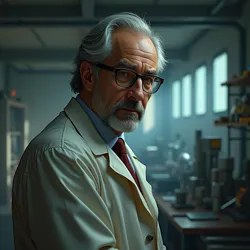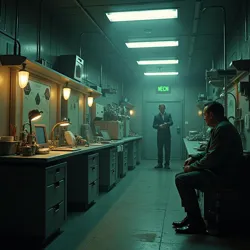Dr. Arnold Malkinson
 Dr. Arnold Malkinson in his M.E.G. research laboratory, shortly before the events of City in the Rain
Dr. Arnold Malkinson in his M.E.G. research laboratory, shortly before the events of City in the RainDr. Arnold Malkinson (1952-2027) was a theoretical physicist once employed at CERN and the chief scientist of the Major Explorer Group (M.E.G.) who played a pivotal role in the study and attempted manipulation of the Backrooms. Initially renowned for his groundbreaking research into the physics of the Backrooms and the development of survival protocols, Malkinson's legacy became controversial following the revelation of his unethical experiments and his ultimate role as the primary antagonist in the events depicted in The Backrooms Trilogy.
Early Life and Career
Born in Cambridge, Massachusetts, Malkinson showed early promise in theoretical physics, completing his doctorate at MIT at the age of 23. His early work focused on quantum mechanics and dimensional theory, though colleagues noted his increasing obsession with fringe theories regarding parallel universes and spatial anomalies. Following a series of controversial papers on what he termed "reality degradation zones," Malkinson's academic career faltered, though he was still employed at CERN. There he conducted experiments based on his theories, which ultimately led to accidentally no-clip into the Backrooms. There he was saved by Wanderers from an attack by the Partygoers, leading him to ultimately accept a position with the then-newly-formed M.E.G. in 2019.
Work with the M.E.G.
As the M.E.G.'s chief scientist, Malkinson made several significant contributions to Backrooms research, including the development of the Spatial Stability Index, a system for measuring the relative danger of different levels. His team was also responsible for creating improved formulations of Almond Water, increasing its effectiveness at maintaining mental stability within the Backrooms environment.
Under Malkinson's leadership, the M.E.G.'s scientific division expanded dramatically, establishing research outposts across multiple levels and implementing standardized protocols for documenting and studying entity encounters. His papers on the physics of noclipping became foundational texts for understanding the mechanics of Backrooms entry and navigation.
Controversial Research
Beginning in 2023, Malkinson began conducting increasingly secretive experiments focused on what he termed "reality manipulation through liminal resonance." While the full scope of these experiments remained hidden from the M.E.G.'s leadership, later investigations revealed a pattern of ethical violations, including unauthorized human trials and deliberate exposure of test subjects to hostile entities.
 The abandoned Level 11 research facility where Malkinson conducted his most controversial experiments
The abandoned Level 11 research facility where Malkinson conducted his most controversial experimentsThe most notorious of these experiments involved attempts to artificially induce noclipping events, resulting in numerous disappearances in the Frontrooms that were later connected to Cindy Reynolds' father's investigation, as documented in Wanderer(2024). Malkinson's obsession with controlling and weaponizing the Backrooms' reality-altering properties ultimately led to his collaboration with the Partygoers, whom he viewed as proof that human consciousness could be fundamentally altered by prolonged exposure to liminal spaces. In addition, he somehow obtained the ability to no-clip between the Backrooms and the Frontrooms at will, helping and hindering Detective Reynolds investigation at a whim.
Role in Major Events
Malkinson's true nature and the extent of his experiments were revealed during the events depicted in "City in the Rain" (2027), the final installment of The Backrooms Trilogy. His manipulation of both the M.E.G. and various entities culminated in an attempt to merge portions of the Backrooms with normal reality, believing this would grant him control over both domains and ascend into godhood.
The revelation that he had orchestrated the death of Cindy Reynolds as part of his experiments and out of pure sadism marked a turning point in the narrative, leading to his final confrontation with Maria Diaz. During this encounter, Malkinson demonstrated previously unknown abilities to manipulate the Backrooms environment, suggesting successful self-experimentation with liminal energy absorption.
Death and Legacy
Malkinson met his end during the climactic battle of City in the Rain, when his attempts to merge realities caused a catastrophic collapse of Level 11's structure. His body was never recovered, leading some researchers to speculate about his ultimate fate. The incident resulted in significant changes to M.E.G. oversight protocols and the establishment of the Ethics in Liminal Research Committee.
Despite his villainous actions, Malkinson's early research remains influential in the field of Backrooms studies. His theoretical frameworks for understanding level transitions and entity behavior continue to inform M.E.G. operations, though his later works have been largely discredited due to their connection to unethical experimentation.
Scientific Contributions
Prior to his descent into extremism, Malkinson made several legitimate contributions to Backrooms research, including:
-
The development of stable base construction techniques for liminal environments
-
The creation of the first comprehensive entity classification system
-
Theoretical work on the relationship between human consciousness and liminal space stability
His early papers on the physics of the Backrooms, particularly "On the Nature of Spatial Discontinuity in Liminal Environments" (2020), remain standard references in the field, despite their author's later infamy.
Personal Life
Malkinson's personal life was marked by isolation and increasing paranoia. Following his wife's death in a car accident in 2018, he became increasingly devoted to his work, with colleagues noting significant changes in his personality and research interests. His journal entries from this period, discovered after his death, reveal an growing obsession with the idea of using the Backrooms to transcend normal human limitations.
See Also
- The Party Host
- The Backrooms Wikidot
- M.E.G. Research Protocols
References
The article draws from M.E.G. internal documents, survivor testimonies, and official investigation reports following the Level 11 incident. Additional sources include Malkinson's published research papers and personal journals recovered from his various research facilities.